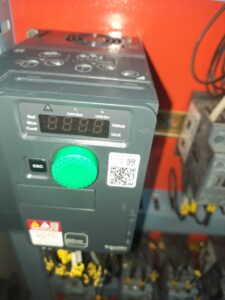Introduction
Variable Frequency Drives (VFDs), also known as Adjustable Frequency Drives (AFDs) or Variable Speed Drives (VSDs), are electronic devices used to control the speed and torque of electric motors. By adjusting the frequency and voltage supplied to the motor, VFDs provide precise control over motor speed, resulting in numerous benefits such as energy savings, improved system performance, and enhanced process control. In this article, we will explore the concept of VFDs in-depth, examining their applications across various industries and discussing why they are crucial for modern motor control systems.
What is a VFD?
Overview of VFD Functionality
Definition and basic operation of VFDs.
How VFDs control motor speed using variable frequency and voltage.
Components and key features of VFDs, including rectifiers, DC bus, inverters, and control algorithms.
Key Advantages of VFDs
1.Energy efficiency
VFDs enable motor speed adjustment to match load requirements, resulting in significant energy savings.
2.Improved process control
Precise speed control allows for better system response, accuracy, and product quality.
3.Soft starting and stopping
VFDs provide gradual motor acceleration and deceleration, reducing mechanical stress and wear on equipment.
Overload protection and fault detection: VFDs monitor motor performance, detect faults, and provide protection against overcurrent, overvoltage, and other issues.
Applications of VFDs
1.HVAC Systems
How VFDs are used in heating, ventilation, and air conditioning systems.
Controlling fan and pump speeds for improved energy efficiency and optimized system performance.
Manufacturing and Industrial Processes
VFD applications in industrial settings, including conveyors, mixers, pumps, compressors, and machine tools.
Benefits of VFDs in terms of energy savings, process optimization, and increased productivity.
2.Water and Wastewater Treatment
Importance of VFDs in controlling pumps, blowers, and other equipment in water and wastewater treatment plants.
Optimized flow control, energy efficiency, and reduced wear and tear on components.
3.Renewable Energy Systems
The role of VFDs in wind turbines and solar panel installations.
Controlling generator speed and optimizing power output.
4.Other Applications
VFD use in elevator systems, escalators, cranes, and material handling equipment.
VFDs in the automotive industry, controlling motor speed in assembly lines and manufacturing processes.
Importance of VFDs
1.Energy Efficiency and Cost Savings
The significant impact of VFDs on energy consumption and operating costs.
Variable speed operation to match motor load and reduce wasted energy.
2.Enhanced Motor Control and Performance:
Precise speed control for improved system response, accuracy, and product quality.
Reduced mechanical stress and wear on motors and other mechanical components.
3.Soft Starting and Stopping:
Gradual acceleration and deceleration of motors to minimize mechanical shocks and stress.
Benefits in terms of equipment longevity and reduced maintenance requirements.
4.Process Optimization and Flexibility:
Dynamic adjustment of motor speed to match changing process requirements.
Enhanced system performance, productivity, and versatility.
5.Advanced Monitoring and Fault Detection:
VFD capabilities in monitoring motor performance, detecting faults, and providing protection against overloads and electrical issues.
Reduced downtime, improved reliability, and increased safety.
Conclusion
Variable Frequency Drives (VFDs) play a vital role in modern motor control systems. By allowing precise speed control, energy efficiency, and enhanced process optimization, VFDs offer significant benefits across a wide range of applications. From HVAC systems to manufacturing processes, water treatment plants to renewable energy systems, VFDs enable optimized performance, energy savings, and improved productivity. Their importance lies in their ability to provide efficient motor control, reduce energy consumption, enhance system performance, and extend the lifespan of equipment. As industries continue to prioritize energy efficiency, sustainability, and process optimization, VFDs will remain essential components in driving technological advancements and achieving operational excellence.











